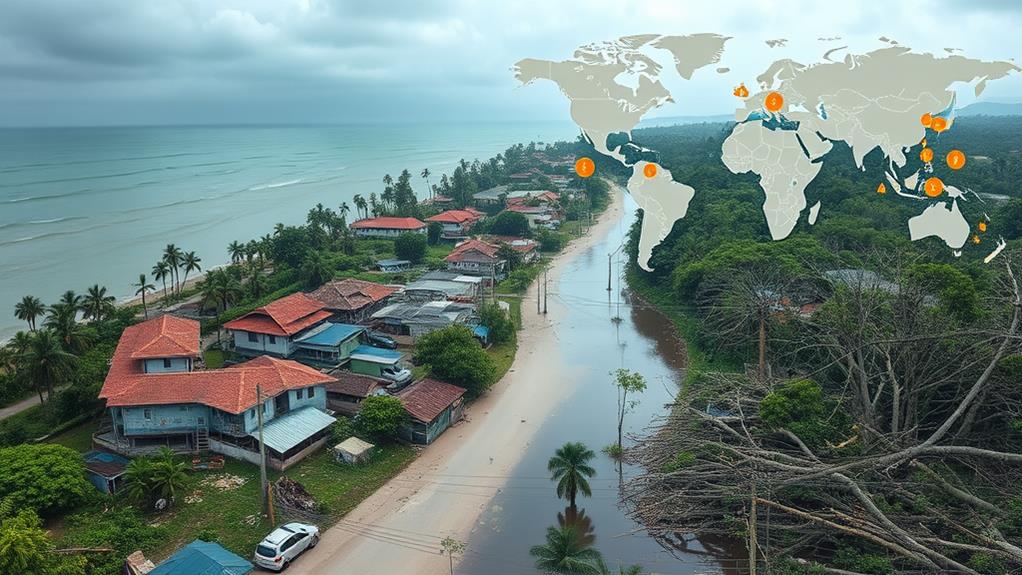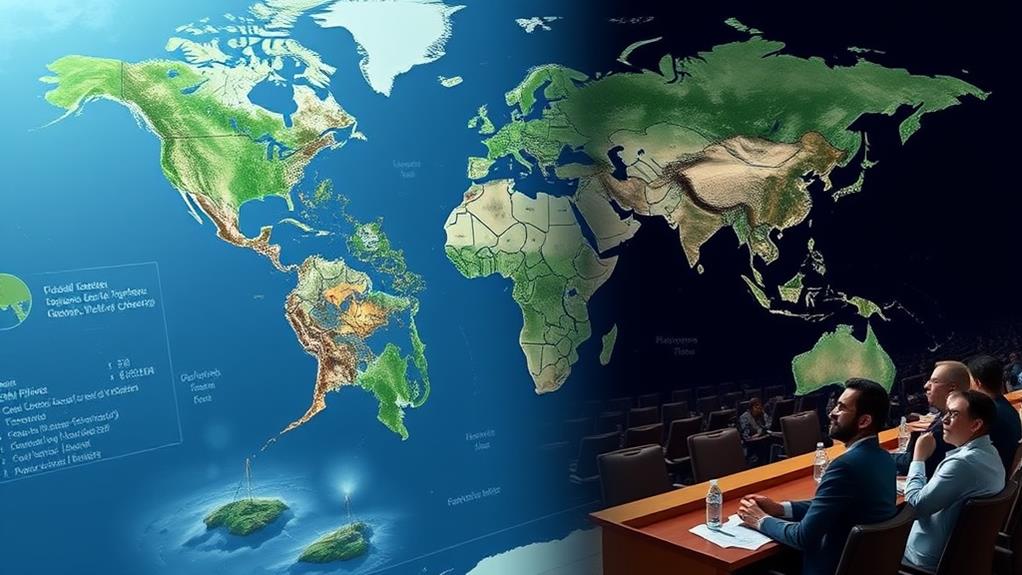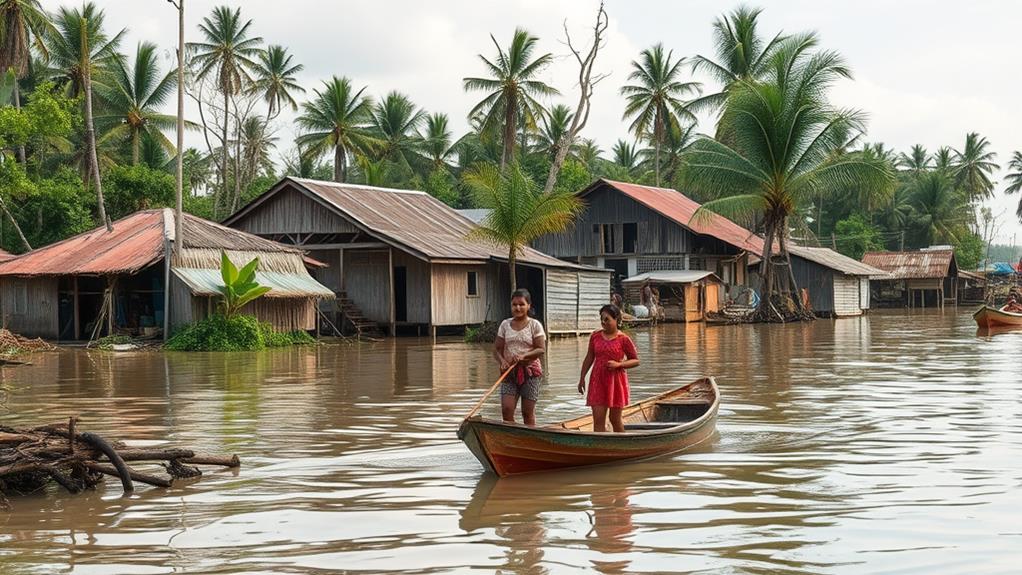The Philippines is highly vulnerable to climate change due to its archipelagic nature and extensive coastline. This vulnerability drives the country to actively engage in international climate negotiations to address its challenges.
The Philippines advocates for climate justice, emphasizing the need for equity, technology transfer, and accountability from major greenhouse gas contributors. As the president of the Climate Vulnerable Forum, the country has set ambitious targets to mitigate greenhouse gas emissions by 75% by 2030.
International partnerships are crucial for the Philippines' climate resilience efforts. Partnerships with entities like the German Federal Ministry for Environment, U.S. EPA, and Japan International Cooperation Agency provide technical assistance and funding for climate resilience projects.
Detailed strategies on adaptation, mitigation, and global climate finance needs highlight the country's urgent call for cooperation. The Philippines has outlined specific plans to address climate change, emphasizing the need for international cooperation to achieve its goals.
Vulnerability to Climate Change

The Philippines' Vulnerability to Climate Change
Geographic Vulnerability
The Philippines is highly susceptible to climate change due to its archipelagic nature and extensive coastline, making it prone to rising sea levels and intense typhoons.
For instance, its fourth longest coastline in the world puts it at risk of devastating natural disasters.
Climate Change Impacts
The Philippines is the fourth most vulnerable country to the long-term impacts of climate change, according to the 2021 Global Climate Risk Index.
On average, at least twenty typhoons make landfall every year, with five predicted to be destructive.
These typhoons exacerbate the intersectional and lasting effects on vulnerable communities, such as farmers, fisherfolk, older persons, the urban poor, and women.
Threats to Biodiversity
The country's biodiversity and ecosystems are under threat.
As one of the 17 mega-biodiverse countries, it contains two-thirds of the earth's biodiversity, making the conservation of natural resources crucial.
The combination of these factors highlights the Philippines' dire need for effective climate adaptation and mitigation strategies to protect its people and environment.
International Climate Commitments
The Philippines' International Climate Commitments
The Philippines, a country severely impacted by climate change, has made significant commitments in international climate discussions. In 2015, the country assumed the presidency of the Climate Vulnerable Forum (CVF) to amplify its voice and advocate for more stringent climate action.
In line with its international commitments, the Philippines has set ambitious targets to mitigate greenhouse gas emissions by 75% by 2030 and adapt to climate change impacts. The country's National Climate Change Action Plan 2011-2028 guides its climate resilience efforts, with support from international partners like the German Federal Ministry for the Environment, Nature Conservation, Building and Nuclear Safety (BMUB).
At COP28, the Philippines reiterated its commitment to reducing emissions and enhancing resilience, calling for increased support for developing countries and the operationalization of the loss and damage fund. This reflects the nation's resolve to address climate change through robust international cooperation and a steadfast commitment to multilateralism.
The Philippines actively participates in global climate negotiations, pushing for key principles such as equity, common but differentiated responsibilities, and urgent implementation through financing and technology transfer. By engaging in these global dialogs, the Philippines seeks to ensure that its voice is heard and its needs are addressed in the fight against climate change.
The preservation of natural resources, such as the Pasig River, is crucial in addressing climate challenges. The historical significance of the Pasig River as a vital artery for trade and communication highlights the need for future conservation efforts to protect such critical waterways.
National Climate Policies

The Philippines has taken significant steps to address climate change through its national policies.
Mainstreaming Climate Resilience: The National Climate Change Action Plan (NCCAP) 2011-2028 guides the country's efforts to mainstream climate resilience into national and sectoral plans. This plan recognizes the crucial role of the Philippines' diverse ecosystems, such as those found in the Sierra Madre, in combating climate change.
These ecosystems provide essential ecosystem services like carbon sequestration and soil stabilization, which are vital for sustainable development and community resilience.
Climate Change Act: The Philippines enacted the Climate Change Act of 2009, which established the Climate Change Commission to formulate and implement climate change policies. This act allocates budgetary resources for critical functions such as vulnerability assessments and capacity building.
Renewable Energy: The Renewable Energy Act of 2008 targets raising the renewable energy capacity from 5 gigawatts to 15 gigawatts by 2030. This includes promoting renewable energy through mechanisms like feed-in tariffs and net metering.
Sectoral Priorities: The NCCAP focuses on seven thematic areas: food security, water sufficiency, ecosystem stability, human security, climate-smart industries, sustainable energy, and knowledge and capacity development.
These priorities aim to address the multifaceted impacts of climate change.
Sub-National Implementation: The government works with local government units to develop climate-adaptive land use and development plans and to access climate financing facilities like the People's Survival Fund.
This ensures that climate policies are effectively implemented at the sub-national level.
These policies and actions demonstrate a structured approach to addressing climate change, though ongoing challenges necessitate continuous improvement and adaptation.
Adaptation and Mitigation Strategies
The Philippines has implemented various adaptation and mitigation strategies to combat climate change. The Climate Change Act of 2009 established the Climate Change Commission (CCC) to oversee climate change programs.
The National Framework Strategy on Climate Change (NFSCC) and the National Climate Change Action Plan (NCCAP) for 2011-2028 outline the country's commitment to adaptation and mitigation, focusing on seven key priorities: food security, water sufficiency, ecological stability, human security, climate-friendly industries, sustainable energy, and knowledge development.
Promoting responsible tourism practices enhances local resilience and ecosystem health while supporting community livelihoods. For instance, eco-tourism initiatives can help achieve this goal.
The Philippine National Adaptation Plan (NAP) 2023-2050 guides the prioritization of actions at national and subnational levels. It aims to reduce vulnerability by building adaptive capacity and integrating climate change adaptation into existing policies.
Specific strategies include developing risk assessments, implementing early warning systems, and promoting sustainable agricultural and fishing practices. The government has also increased climate change funds, allocating 83% for adaptation and 17% for mitigation, demonstrating a strong commitment to addressing climate change impacts.
These efforts are designed to strengthen the country's resilience and economic stability in the face of climate risks.
Global Climate Finance Needs

The Philippines relies heavily on global climate finance to adapt to and mitigate the impacts of climate change, which poses significant economic threats to the country.
Substantial Financial Needs
The Philippines requires substantial financial support to implement necessary adaptation and mitigation measures. For instance, the country's unique ecosystems, such as the Underground River, highlight the importance of preserving natural wonders while addressing climate change challenges.
Key Financial Requirements
The country has four key financial requirements:
Doubling Adaptation Finance is necessary, but the global commitment of $40 billion by 2025 falls short of the actual needs. Developing nations like the Philippines require up to $387 billion annually to fully implement their adaptation policies.
The Philippines also wants to Operationalize the Loss and Damage Fund, which would provide urgent and responsive means of implementation, including capacity building, technology transfer, and financing. The country has even expressed its desire to host the Board of the Loss and Damage Fund.
Climate Justice and Equity are essential, as developed countries must take responsibility for their historical greenhouse gas emissions and provide fair financing to support vulnerable countries like the Philippines.
Finally, the Philippines aims to increase its share of Renewable Energy to 35% by 2030 and 50% by 2040, which requires significant investment in clean energy infrastructure.
These financial needs underscore the critical role of global climate finance in supporting the Philippines' climate resilience and sustainable development goals.
Role of International Partnerships
International partnerships play a vital role in supporting the Philippines' climate change mitigation and adaptation efforts. One such partnership is with the German Federal Ministry for the Environment, Nature Conservation, Building and Nuclear Safety (BMUB), which has funded projects like "Support to the Philippines in shaping and implementing the international climate regime" (SupportCCC II).
This project helped mainstream climate resilience in national and sectoral plans and promoted renewable energy. Additionally, initiatives aimed at protecting Sierra Madre's rich biodiversity enhance the country's environmental stability, which is vital for effective climate action.
The United States Environmental Protection Agency (EPA) has collaborated with the Philippines Department of Environment and Natural Resources (DENR) to address environmental issues. A memorandum of understanding (MOU) was signed to enhance cooperation on climate change adaptation, air quality, and solid waste management.
The Japan International Cooperation Agency (JICA) has also partnered with the Climate Change Commission (CCC) to identify areas of cooperation that align with the Philippine Nationally Determined Contribution (NDC) goals.
These partnerships focus on projects such as climate policy development and infrastructure resilience. Overall, these international partnerships provide critical technical assistance, funding, and expertise, enabling the Philippines to better address its climate change challenges.
Impact on Marginalized Communities

Marginalized communities in the Philippines are disproportionately affected by climate change, despite the country's minimal contribution to global greenhouse gas emissions. These communities, often living in precarious conditions, face exacerbated vulnerabilities due to climate-related disasters.
Climate Change Exacerbates Existing Vulnerabilities
The effects on these communities are multifaceted:
Livelihood Disruption: Unpredictable weather patterns, rising sea levels, and destructive typhoons threaten the livelihoods of farmers and fisherfolk.
For example, in 2020, Typhoon Vongfong caused widespread damage to crops and fisheries, resulting in significant economic losses for local communities.
Forced Migration: Climate emergencies lead to both planned and unplanned migrations, with women representing 80% of those displaced.
This displacement further erodes their economic security and social stability. In 2013, Typhoon Haiyan displaced over 4 million people, with many women forced to migrate to urban areas in search of work.
Health Impacts: Marginalized communities experience heightened health risks from climate-driven events such as floods and heatwaves, which can exacerbate existing health conditions.
For instance, flooding can contaminate water sources, leading to the spread of waterborne diseases.
Social Inequality: Climate change amplifies existing social inequalities, as poorer populations lack the resources and infrastructure to adapt and recover from climate-related disasters.
In the Philippines, the poorest 20% of the population are disproportionately affected by climate-related disasters, further widening the gap between the rich and the poor.
Tailored Solutions Needed
These challenges underscore the need for tailored adaptation and mitigation strategies that prioritize the needs of marginalized communities, ensuring their voices are heard in climate negotiations and policy implementations.
Advocacy for Climate Justice
Climate Justice Advocacy in the Philippines
The Philippines is a strong advocate for climate justice due to its high vulnerability to climate change impacts despite being a small contributor to greenhouse gas emissions.
The country's vulnerability is evident in the struggles faced by communities dependent on sustainable agriculture, such as the Ifugao people and their ancient rice terraces, which showcase remarkable adaptability to environmental challenges.
Global Advocacy
At global forums like the Conference of the Parties (COP) to the United Nations Framework Convention on Climate Change, the Philippines champions the cause of equity and common but differentiated responsibilities.
It emphasizes the need for urgent and responsive measures, including capacity building, technology transfer, and financing, particularly for developing countries.
Holding Major Contributors Accountable
The Philippines demands accountability from major greenhouse gas contributors, arguing that they must support the most affected nations through climate finance, technology transfer, and capacity building.
The country seeks the operationalization of the Loss and Damage Fund, ensuring that vulnerable communities are prioritized in accessing funds for adaptation and sustainable rebuilding.
Questions and Answers
How Can Technology Transfer Support Climate Action in the Philippines?
Technology transfer is crucial for supporting climate action in the Philippines. One effective way to do this is by leveraging partnerships, such as the U.S. Cooperative Technology Partnership, to transfer renewable energy technologies.
This approach can enhance energy services in rural areas, where access to energy is often limited.
To achieve this, priority technologies need to be identified, followed by engagement with stakeholders and removal of barriers to implementation.
Effective technology transfer can help mitigate greenhouse gas (GHG) emissions by reducing dependence on fossil fuels and promoting sustainable development.
This can be achieved by integrating climate change concerns into national development plans, ensuring a sustainable future for the Philippines.
What Are the Educational Initiatives to Raise Climate Awareness in the Philippines?
Educational initiatives play a crucial role in raising climate awareness in the Philippines.
The National Environmental Awareness and Education Act mandates environmental education in school curricula, ensuring that climate education is integrated into the learning process.
Programs like Klima Eskwela, a collaboration between Climate Reality Philippines and the Department of Education, promote climate literacy and awareness among students. Additionally, the Department of Education has incorporated climate change modules into the K-12 curriculum, providing students with a comprehensive understanding of the issue.
Other initiatives focus on fostering climate literacy and action among students. The Green School Program, for instance, encourages environmentally friendly practices in schools, while the Youth for Environment in Schools Organization (YES-O) empowers students to take action against climate change.
These initiatives equip students with the knowledge and skills necessary to address the climate crisis.
How Can Local Businesses Contribute to Climate Resilience Efforts?
Local businesses can contribute to climate resilience efforts by incorporating strategic risk management. This involves assessing and mitigating climate hazards, such as flooding or heatwaves, that could impact operations. For example, a business can invest in climate-resilient infrastructure, like flood-proof storage facilities or heat-resistant roofing materials.
Integrate climate considerations into daily operations. Adopt sustainable practices, such as reducing energy consumption or implementing recycling programs, to minimize your carbon footprint.
Leverage data-driven approaches to enhance resilience by monitoring climate-related data and using it to inform business decisions.
Engage with stakeholders and collaborate with government agencies to support community-based adaptation projects. This can include partnering with local organizations to develop climate-resilient infrastructure or providing resources for climate-related emergency response plans.
What Role Can International NGOS Play in Supporting Philippine Climate Goals?
International NGOs can support Philippine climate goals by leveraging their expertise, resources, and global networks.
They can provide advice on climate policy, such as helping to develop and implement effective climate change mitigation and adaptation strategies. For example, NGOs like the Institute for Climate and Sustainable Cities (ICSC) can offer expertise on low-carbon development, helping the Philippines transition to a more sustainable and environmentally-friendly economy.
Additionally, international NGOs can mobilize international support by raising awareness about the Philippines' climate challenges and opportunities, and facilitate climate finance transparency and accountability by ensuring that climate funds are used effectively and efficiently.
They can also provide technical assistance, such as training and capacity-building programs, to help the Philippines build its climate resilience and policy implementation capacity.
How Are Climate Change Impacts Affecting Philippine Cultural Heritage Sites?
Climate change is threatening the integrity of Philippine cultural heritage sites. The Banaue Rice Terraces, a prime example, are being severely impacted by rising temperatures, increased precipitation, and more frequent extreme weather events.
These changes are compromising the structural integrity of the terraces, which were built over 2,000 years ago. The terraces' walls are crumbling, and the water supply systems are being disrupted, affecting traditional agricultural practices.
The cultural landscapes are also being eroded, which risks the loss of traditional land use practices, cultural traditions, and indigenous knowledge.
For instance, the Ifugao people, who built the rice terraces, are struggling to maintain their traditional farming practices due to the changing weather patterns.
The loss of these practices would be irreversible, highlighting the urgent need for adaptive strategies and conservation efforts to preserve the cultural heritage of the Philippines.